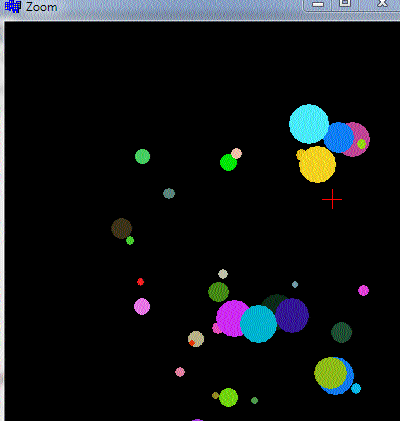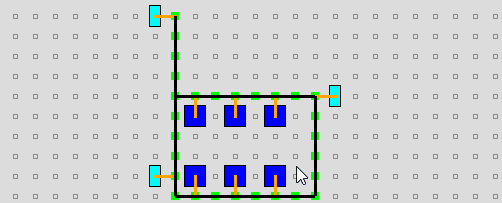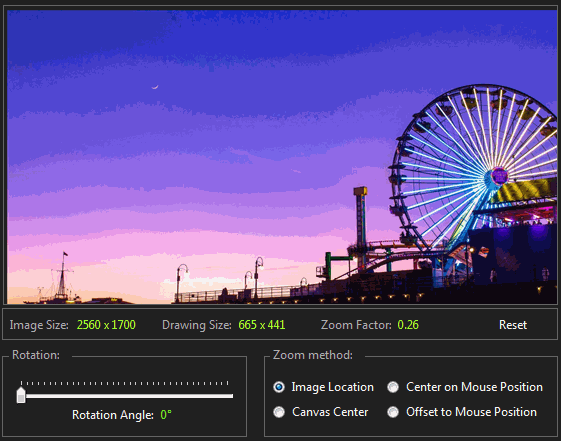Zooming graphics based on current mouse position
Too lazy to make the equations right (and most likely would made similar mistake as you... I do not know if it is just me but exactly this easy stuff I cant handle and drives me mad). Instead I am dealing with this kind of tasks as follows (it is much safer from mistakes):
create transform functions between screen and world coordinates
So your mouse position is in screen coordinates and rendered stuff is in world coordinates. As this is only 2D then it is easy. make function that converts between these two. Your world to screen transform (if I am not overlooking something) is this:
g.ScaleTransform(_scale, _scale);
g.TranslateTransform(_translateX, _translateY);so:
screen_x=(world_x*_scale)+_translateX;
screen_y=(world_y*_scale)+_translateY;So the reverse:
world_x=(screen_x-_translateX)/_scale;
world_y=(screen_y-_translateY)/_scale;change of zoom/scale
The idea is that after zoom/scale change the mouse position should stay the same in world coordinates as before. so remember world coordinates of mouse before change. Then compute from it the screen position after change and the difference put into translation.
Here simple C++ example:
double x0=0.0,y0=0.0,zoom=1.0,mx,my;
//---------------------------------------------------------------------------
void scr2obj(double &ox,double &oy,double sx,double sy)
{
ox=(sx-x0)/zoom;
oy=(sy-y0)/zoom;
}
//---------------------------------------------------------------------------
void obj2scr(double &sx,double &sy,double ox,double oy)
{
sx=x0+(ox*zoom);
sy=y0+(oy*zoom);
}
//---------------------------------------------------------------------------
void __fastcall TForm1::FormMouseWheelDown(TObject *Sender, TShiftState Shift,TPoint &MousePos, bool &Handled)
{
double mx0,my0;
scr2obj(mx0,my0,mx,my);
zoom/=1.25; // zoom out
obj2scr(mx0,my0,mx0,my0);
x0+=mx-mx0;
y0+=my-my0;
_redraw=true;
}
//---------------------------------------------------------------------------
void __fastcall TForm1::FormMouseWheelUp(TObject *Sender, TShiftState Shift, TPoint &MousePos, bool &Handled)
{
double mx0,my0;
scr2obj(mx0,my0,mx,my);
zoom*=1.25; // zoom in
obj2scr(mx0,my0,mx0,my0);
x0+=mx-mx0;
y0+=my-my0;
_redraw=true;
}
//---------------------------------------------------------------------------
void __fastcall TForm1::FormMouseMove(TObject *Sender, TShiftState Shift, int X,int Y)
{
mx=X; my=Y;
}
//---------------------------------------------------------------------------
the mx,my is actual mouse position in screen coordinates, the x0,y0 is the translation and zoom is the scale.
And here captured GIF animation of this:

[edit1] It looks like your gfx objects use transponed matrices
That means the order of transformations is reversed so the equations change a bit... Here your case example in C++:
void scr2obj(double &ox,double &oy,double sx,double sy)
{
// ox=(sx-x0)/zoom;
// oy=(sy-y0)/zoom;
ox=(sx/zoom)-x0;
oy=(sy/zoom)-y0;
}
//---------------------------------------------------------------------------
void obj2scr(double &sx,double &sy,double ox,double oy)
{
// sx=x0+(ox*zoom);
// sy=y0+(oy*zoom);
sx=(x0+ox)*zoom;
sy=(y0+oy)*zoom;
}
//---------------------------------------------------------------------------
void __fastcall TForm1::FormMouseWheelDown(TObject *Sender, TShiftState Shift,TPoint &MousePos, bool &Handled)
{
double mx0,my0;
scr2obj(mx0,my0,mx,my);
zoom/=1.25; // zoom out
obj2scr(mx0,my0,mx0,my0);
// x0+=mx-mx0;
// y0+=my-my0;
x0+=(mx-mx0)/zoom;
y0+=(my-my0)/zoom;
_redraw=true;
}
//---------------------------------------------------------------------------
void __fastcall TForm1::FormMouseWheelUp(TObject *Sender, TShiftState Shift, TPoint &MousePos, bool &Handled)
{
double mx0,my0;
scr2obj(mx0,my0,mx,my);
zoom*=1.25; // zoom in
obj2scr(mx0,my0,mx0,my0);
// x0+=mx-mx0;
// y0+=my-my0;
x0+=(mx-mx0)/zoom;
y0+=(my-my0)/zoom;
_redraw=true;
}
//---------------------------------------------------------------------------
Image zoom centered on mouse position
The key to solving this puzzle is to understand how the image gets enlarged. If we're using a zoom factor of 1.2, the image becomes 20% larger. We assign 1.2 to the variable factor and do the following:
image.setScaleX(image.getScaleX() * factor);
image.setScaleY(image.getScaleY() * factor);
The upper left corner of the image stays in the same place while the picture is enlarged. Now consider the point under the mouse cursor. Every pixel above and to the left of the cursor has become 20% larger. This displaces the point under the cursor by 20% downward and to the right. Meanwhile, the cursor is in the same position.
To compensate for the displacement of the point under the cursor, we move the image so that the point gets back under the cursor. The point moved down and right; we move the image up and left by the same distance.
Note that the image might have been moved in the canvas before the zooming operation, so the cursor's horizontal position in the image is currentMouseX - image.getLeft() before zooming, and likewise for the vertical position.
This is how we calculate the displacement after zooming:
var dx = (currentMouseX - image.getLeft()) * (factor - 1),
dy = (currentMouseY - image.getTop()) * (factor - 1);
Finally, we compensate for the displacement by moving the point back under the cursor:
image.setLeft(image.getLeft() - dx);
image.setTop(image.getTop() - dy);
I integrated this calculation into your demo and made the following fiddle:
https://jsfiddle.net/fgLmyxw4/
I also implemented the zoom-out operation.
Java Graphics2D - Zoom on mouse location
I solved the problem by implementing what is being described here
Here is the updated code:
public class MyPanel extends JPanel {
...
private double zoom = 1;
private int zoomPointX;
private int zoomPointY;
...
class CustomMouseWheelListener implements MouseWheelListener {
@Override
public void mouseWheelMoved(MouseWheelEvent e) {
zoomPointX = e.getX();
zoomPointY = e.getY();
if (e.getPreciseWheelRotation() < 0) {
zoom -= 0.1;
} else {
zoom += 0.1;
}
if (zoom < 0.01) {
zoom = 0.01;
}
repaint();
}
}
...
protected void paintComponent(Graphics g) {
Graphics2D g2D = (Graphics2D) g;
super.paintComponent(g2D);
AffineTransform at = g2D.getTransform();
at.translate(zoomPointX, zoomPointY);
at.scale(zoom, zoom);
at.translate(-zoomPointX, -zoomPointY);
g2D.setTransform(at);
a_different_class_where_i_do_some_drawing.draw(g2D);
}
}

Zoom and translate an Image from the mouse location
A few suggestions and a couple of tricks.
Not exactly tricks, just some methods to speed up the calculations when more than one graphic transformation is in place.
Divide and conquer: split the different graphics effects and transformations in different, specialized, methods that do one thing. Then design in a way that makes it possible for these methods to work together when needed.
Keep it simple: when Graphics objects need to accumulate more than a couple of transformations, the order in which Matrices are stacked can cause misunderstandings. It's simpler (and less prone to generate weird outcomes) to calculate some generic transformations (translate and scale, mostly) beforehand, then let GDI+ render already pre-cooked objects and shapes.
Here, only Matrix.RotateAt and Matrix.Multiply are used.
Some notes about Matrix transformations here: Flip the GraphicsPathUse the right tools: for example, a Panel used as canvas is not exactly the best choice. This Control is not double-buffered; this feature can be enabled, but the Panel class is not meant for drawing, while a PictureBox (or a non-System flat Label) supports it on its own.
Some more notes here: How to apply a fade transition effect to Images
The sample code shows 4 zoom methods, plus generates rotation transformations (which work side-by-side, don't accumulate).
The Zoom modes are selected using an enumerator (private enum ZoomMode):
Zoom modes:
ImageLocation: Image scaling is performed in-place, keeping the current Location on the canvas in a fixed position.CenterCanvas: while the Image is scaled, it remains centered on the Canvas.CenterMouse: the Image is scaled and translated to center itself on the current Mouse location on the Canvas.MouseOffset: the Image is scaled and translated to maintain a relative position determined by the initial location of the Mouse pointer on the Image itself.
You can notice that the code simplifies all the calculations, applying translations exclusively relative to the Rectangle that defines the current Image bounds and only in relation to the Location of this shape.
The Rectangle is only scaled when the calculation needs to preemptively determine what the Image size will be after the Mouse Wheel has generated the next Zoom factor.
Visual sample of the implemented functionalities:

Sample code:
canvasis the Custom Control, derived from PictureBox (you can find its definition at the bottom). This control is added to the Form in code, here. Modify as needed.trkRotationAngleis the TrackBar used to define the current rotation of the Image. Add this control to the Form in the designer.radZoom_CheckedChangedis the event handler of all the RadioButtons used to set the current Zoom Mode. The value these Controls set is assigned in theirTagproperty. Add these controls to the Form in the designer.
using System.Drawing;
using System.Drawing.Drawing2D;
using System.IO;
using System.Windows.Forms;
public partial class frmZoomPaint : Form
{
private float rotationAngle = 0.0f;
private float zoomFactor = 1.0f;
private float zoomStep = .05f;
private RectangleF imageRect = RectangleF.Empty;
private PointF imageLocation = PointF.Empty;
private PointF mouseLocation = PointF.Empty;
private Bitmap drawingImage = null;
private PictureBoxEx canvas = null;
private ZoomMode zoomMode = ZoomMode.ImageLocation;
private enum ZoomMode
{
ImageLocation,
CenterCanvas,
CenterMouse,
MouseOffset
}
public frmZoomPaint()
{
InitializeComponent();
string imagePath = [Path of the Image];
drawingImage = (Bitmap)Image.FromStream(new MemoryStream(File.ReadAllBytes(imagePath)));
imageRect = new RectangleF(Point.Empty, drawingImage.Size);
canvas = new PictureBoxEx(new Size(555, 300));
canvas.Location = new Point(10, 10);
canvas.MouseWheel += canvas_MouseWheel;
canvas.MouseMove += canvas_MouseMove;
canvas.MouseDown += canvas_MouseDown;
canvas.MouseUp += canvas_MouseUp;
canvas.Paint += canvas_Paint;
Controls.Add(canvas);
}
private void canvas_MouseWheel(object sender, MouseEventArgs e)
{
mouseLocation = e.Location;
float zoomCurrent = zoomFactor;
zoomFactor += e.Delta > 0 ? zoomStep : -zoomStep;
if (zoomFactor < .10f) zoomStep = .01f;
if (zoomFactor >= .10f) zoomStep = .05f;
if (zoomFactor < .0f) zoomFactor = zoomStep;
switch (zoomMode) {
case ZoomMode.CenterCanvas:
imageRect = CenterScaledRectangleOnCanvas(imageRect, canvas.ClientRectangle);
break;
case ZoomMode.CenterMouse:
imageRect = CenterScaledRectangleOnMousePosition(imageRect, e.Location);
break;
case ZoomMode.MouseOffset:
imageRect = OffsetScaledRectangleOnMousePosition(imageRect, zoomCurrent, e.Location);
break;
default:
break;
}
canvas.Invalidate();
}
private void canvas_MouseDown(object sender, MouseEventArgs e)
{
if (e.Button != MouseButtons.Left) return;
mouseLocation = e.Location;
imageLocation = imageRect.Location;
canvas.Cursor = Cursors.NoMove2D;
}
private void canvas_MouseMove(object sender, MouseEventArgs e)
{
if (e.Button != MouseButtons.Left) return;
imageRect.Location =
new PointF(imageLocation.X + (e.Location.X - mouseLocation.X),
imageLocation.Y + (e.Location.Y - mouseLocation.Y));
canvas.Invalidate();
}
private void canvas_MouseUp(object sender, MouseEventArgs e) =>
canvas.Cursor = Cursors.Default;
private void canvas_Paint(object sender, PaintEventArgs e)
{
var drawingRect = GetDrawingImageRect(imageRect);
using (var mxRotation = new Matrix())
using (var mxTransform = new Matrix()) {
e.Graphics.InterpolationMode = InterpolationMode.HighQualityBicubic;
e.Graphics.PixelOffsetMode = PixelOffsetMode.Half;
mxRotation.RotateAt(rotationAngle, GetDrawingImageCenterPoint(drawingRect));
mxTransform.Multiply(mxRotation);
e.Graphics.Transform = mxTransform;
e.Graphics.DrawImage(drawingImage, drawingRect);
}
}
private void trkRotationAngle_ValueChanged(object sender, EventArgs e)
{
rotationAngle = trkAngle.Value;
canvas.Invalidate();
canvas.Focus();
}
private void radZoom_CheckedChanged(object sender, EventArgs e)
{
var rad = sender as RadioButton;
if (rad.Checked) {
zoomMode = (ZoomMode)int.Parse(rad.Tag.ToString());
}
canvas.Focus();
}
#region Drawing Methods
public RectangleF GetScaledRect(RectangleF rect, float scaleFactor) =>
new RectangleF(rect.Location,
new SizeF(rect.Width * scaleFactor, rect.Height * scaleFactor));
public RectangleF GetDrawingImageRect(RectangleF rect) =>
GetScaledRect(rect, zoomFactor);
public PointF GetDrawingImageCenterPoint(RectangleF rect) =>
new PointF(rect.X + rect.Width / 2, rect.Y + rect.Height / 2);
public RectangleF CenterScaledRectangleOnCanvas(RectangleF rect, RectangleF canvas)
{
var scaled = GetScaledRect(rect, zoomFactor);
rect.Location = new PointF((canvas.Width - scaled.Width) / 2,
(canvas.Height - scaled.Height) / 2);
return rect;
}
public RectangleF CenterScaledRectangleOnMousePosition(RectangleF rect, PointF mousePosition)
{
var scaled = GetScaledRect(rect, zoomFactor);
rect.Location = new PointF(mousePosition.X - (scaled.Width / 2),
mousePosition.Y - (scaled.Height / 2));
return rect;
}
public RectangleF OffsetScaledRectangleOnMousePosition(RectangleF rect, float currentZoom, PointF mousePosition)
{
var currentRect = GetScaledRect(imageRect, currentZoom);
if (!currentRect.Contains(mousePosition)) return rect;
float scaleRatio = currentRect.Width / GetScaledRect(rect, zoomFactor).Width;
PointF mouseOffset = new PointF(mousePosition.X - rect.X, mousePosition.Y - rect.Y);
PointF scaledOffset = new PointF(mouseOffset.X / scaleRatio, mouseOffset.Y / scaleRatio);
PointF position = new PointF(rect.X - (scaledOffset.X - mouseOffset.X),
rect.Y - (scaledOffset.Y - mouseOffset.Y));
rect.Location = position;
return rect;
}
#endregion
}
The simple PictureBoxEx custom control (modify and extend as needed):
This PictureBox is selectable, so it can be focused, with a Mouse click
using System.ComponentModel;
using System.Drawing;
using System.Windows.Forms;
[DesignerCategory("Code")]
public class PictureBoxEx : PictureBox
{
public PictureBoxEx() : this (new Size(200, 200)){ }
public PictureBoxEx(Size size) {
SetStyle(ControlStyles.Selectable | ControlStyles.UserMouse, true);
BorderStyle = BorderStyle.FixedSingle;
Size = size;
}
}
Zoom in/out at mouse position in canvas
In my mind, the way zoom works is that based on the position of the point of interest (in your case mouse), the zoom has a weighted impact on the (x, y) position of the canvas. If the mouse is at the top left, this weight should be (0,0), if it's at the bottom right, it should be (1,1). And the centre should be (0.5,0.5).
So, assuming we have the weights, whenever the zoom changes, the weights show us how far the top left corner of the canvas is from the point of interest, and we should move it away by the weight*dimension*(delta zoom).
Note that in order to calculate the weights, we need to consider the zoomed in/out value of the dimensions. So if width is 100 and zoom is 0.5, we should assume the width is 50. So all the values would be absolute (since the mouse (x,y) are absolute).
so, it's like:
function worldZoom(e) {
const {x, y, deltaY} = e;
const direction = deltaY > 0 ? -1 : 1;
const factor = 0.01;
const zoom = 1 * direction * factor;
// compute the weights for x and y
const wx = (x-controls.view.x)/(width*controls.view.zoom);
const wy = (y-controls.view.y)/(height*controls.view.zoom);
// apply the change in x,y and zoom.
controls.view.x -= wx*width*zoom;
controls.view.y -= wy*height*zoom;
controls.view.zoom += zoom;
}
You can try it in this codepen.
Or a bit simpler, compute the weights inline:
controls.view.x -= (x-controls.view.x)/(controls.view.zoom)*zoom;
controls.view.y -= (y-controls.view.y)/(controls.view.zoom)*zoom;
controls.view.zoom += zoom;
Related Topics
Mvvm: Binding Radio Buttons to a View Model
How to Find Out When You'Ve Been Loaded via Xml Serialization
Best Programming Practice of Using Dropdownlist in ASP.NET MVC
Returning Http Status Code from Web API Controller
How Would You Make a Unique Filename by Adding a Number
Combobox- Selectionchanged Event Has Old Value, Not New Value
Calling a Soap Service in .Net Core
How to Make a Hyperlink Work in a Richtextbox
Azure Ad B2C - Role Management
C#: Should Object Variables Be Assigned to Null
How to Find the State of Numlock, Capslock and Scrolllock in .Net
Gps Socket Communication (Concox)
How to Change the Background Color of All Other Forms from One Form
Dependency Injection Using Azure Webjobs Sdk